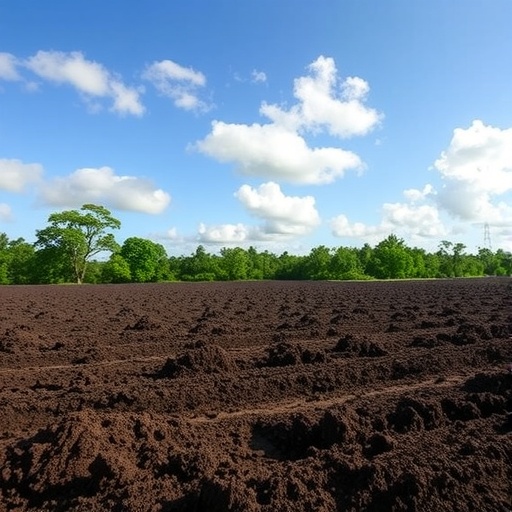In a groundbreaking study published in Nature Communications, researchers have unveiled the striking reality of how land use changes in the dry tropics are driving significant soil carbon losses, nearly counterbalancing the carbon sequestration gains observed in the planet’s northern regions. This complex interplay between regional ecosystems challenges conventional narratives about global carbon sinks and highlights an urgent need to reshape strategies for climate mitigation.
Soil carbon, the organic material stored within earth’s soil, plays a critical role in the global carbon cycle by acting as both a sink and source of atmospheric carbon dioxide (CO2). Understanding the balance of carbon storage and release is crucial because it directly influences global temperature regulation and climate dynamics. The study illuminates how human activities, particularly in arid tropical environments, are accelerating the depletion of this vital soil carbon reservoir, jeopardizing efforts to combat climate change.
The researchers meticulously analyzed carbon fluxes across a broad latitudinal gradient, focusing on contrasting land use patterns between the dry tropics and northern latitudes. Their findings indicate that while northern forested regions have exhibited elevated carbon uptake due to reforestation efforts and climate-related growth enhancements, these positive developments are nearly offset by carbon released from soils in tropical drylands where land use intensification has been rampant.
Dry tropical regions, characterized by sparse vegetation and seasonal rainfall, are exceptionally sensitive to disturbances caused by agriculture, deforestation, and urban expansion. The conversion of natural vegetation to cropland often involves soil tillage and clearing, exacerbating soil carbon oxidation and subsequent emissions. This process undermines the land’s innate capacity to sequester carbon, transforming it into a net carbon source rather than a sink.
The implications of these findings are profound. Historically, climate models tended to emphasize northern latitudes as key areas for carbon sequestration, especially given accelerating plant growth stimulated by warming conditions and CO2 fertilization effects. However, the newly revealed carbon losses in tropical drylands challenge this paradigm, suggesting that global net carbon uptake may be substantially lower than previously estimated.
Intriguingly, the study employed advanced satellite observations combined with field measurements to estimate soil carbon stock changes across diverse biomes. This integrative approach allowed for precise quantification of both natural and anthropogenic impacts, revealing nuanced spatial variations in soil carbon dynamics that were not captured in earlier research reliant solely on ground-based surveys or coarse-resolution remote sensing.
The temporal analysis conducted in the study underscores how land management decisions made over recent decades have shaped current soil carbon budgets. The intensification of agriculture to meet growing food demands in dry tropical zones has triggered considerable soil degradation and subsequent carbon loss. Meanwhile, northern ecosystems benefit from conservation, reforestation, and longer growing seasons, amplifying their carbon storage capabilities.
This dichotomy raises critical questions about equity and sustainability in global land management. Regions contributing disproportionately to soil carbon emissions due to socio-economic pressures often receive less international support for conservation. Addressing these imbalances is essential for cultivating collaborative climate solutions that acknowledge both local livelihoods and planetary health.
Furthermore, the study calls for a reevaluation of carbon accounting frameworks used in international climate agreements. Accurate recognition of soil carbon emissions from tropical dryland land use change is imperative for fair, transparent reporting and effective policy development. Neglecting these emissions risks overestimating progress toward emission reduction targets.
The researchers advocate for integrated land-use policies that prioritize sustainable agriculture, soil restoration, and the protection of native vegetation, especially in vulnerable dry tropical regions. Adopting regenerative farming practices that enhance soil organic matter, reduce erosion, and improve water retention can reverse soil carbon decline and contribute to climate resilience.
Moreover, the study stresses the importance of incorporating local stakeholder knowledge and community-based natural resource management to ensure that conservation initiatives are contextually appropriate and socially equitable. Empowering local populations with incentives and resources can create co-benefits for biodiversity, food security, and carbon sequestration.
This research also highlights significant knowledge gaps concerning the interactions between climate change, land use, and soil carbon processes under varying environmental conditions. It calls for expanded monitoring networks and high-resolution data collection to refine global carbon budget models and improve predictive accuracy for future scenarios.
In conclusion, the nearly equal but opposite carbon fluxes identified between the drying tropics and northern lands underscore the delicate balance maintained in the global carbon cycle. Disrupting one side without accounting for losses on the other may hinder meaningful progress in curbing atmospheric CO2 concentrations. As the scientific community continues to untangle these complex feedbacks, such comprehensive assessments are vital for crafting holistic strategies that address regional disparities and foster global climate stabilization.
The profound insights emerging from this study amplify the urgency of rethinking land use across biomes and elevating soil carbon management to a central position in climate policy. Encouraging sustainable land stewardship worldwide, particularly in the dry tropics, promises to unlock untapped potential in the fight against climate change and secure a more stable environment for future generations.
Subject of Research: Soil carbon dynamics and land use impact on global carbon balance
Article Title: Land use-induced soil carbon loss in the dry tropics nearly offsets gains in northern lands.
Article References:
Wang, H., Ciais, P., Yang, H. et al. Land use-induced soil carbon loss in the dry tropics nearly offsets gains in northern lands. Nat Commun 16, 10008 (2025). https://doi.org/10.1038/s41467-025-64929-3
Image Credits: AI Generated




